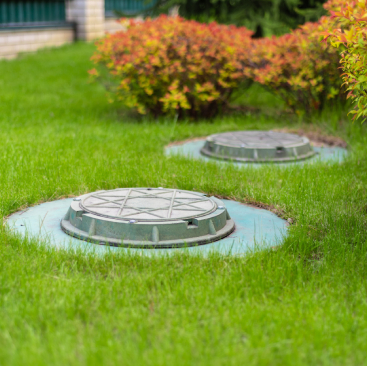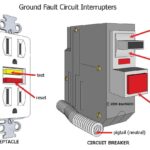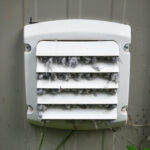GFCI and AFCI Protection
What is a GFCI? Continue Reading

Before you buy a home with a Septic system, have one of our licensed home and Septic system inspectors ensure that you’re not going to need to replace it anytime soon.
What is a Septic System?
Septic systems consist of an underground tank, and a leach or drain field, that together treat and disperse relatively small volumes of wastewater from a home. Homeowners are responsible for maintaining their septic systems. Your home is a huge investment, and a septic system is one of the most costly components of a home to replace.
Properly designed, constructed, and maintained systems can provide safe and long-term treatment of household waste, and can help prevent a septic system from failing. Regular maintenance includes inspections of your septic system and its components, and pump-outs. These relatively inexpensive practices can help your system last for decades and avoid costly repairs. Failing septic systems can not only cost you thousands of dollars to dig up and replace, but it can contaminate the groundwater that you and your neighbors drink and can pollute nearby rivers and lakes.
How does a septic system work?
A typical septic system has four main components:

Wastewater from the toilets, sink, or laundry drains from your house, through pipes, into the septic tank.
The septic tank is a buried, watertight container that is typically made of concrete, fiberglass, or polyethylene. In the tank, bacteria begin to break down the material in the wastewater. The tanks are designed to hold wastewater long enough to allow the solids to settle on the bottom. This is known as sludge, and consists of solids not broken down by bacteria, as well as the by-products of the bacterial digestion. A layer of scum forms on the top, and this is composed of oil, grease, and fats. The scum layer on top helps keep the tank airtight, allowing bacteria to better breakdown the material in the tank.
Compartments and a T-shaped outlet in the septic tank prevent the solids in the sludge and scum from leaving the tank through the outlet pipe, and traveling into the drain field area. Screens or filters are also recommended to keep solids from entering the drain field. The partially treated wastewater then exits the septic tank through an outlet pipe and gradually seeps into the drain field through small holes in the pipes. The drain field is a large area where wastewater is further treated. Natural filtration and bacteria in the soil remove any remaining harmful particles in the wastewater before it reaches the groundwater.
Properly functioning systems that are regularly pumped out usually have very little solids that exit the tank. However, if the scum and sludge build up and are not pumped out, the solids can flow to the drain field and block the small holes in the pipes, damaging the system.
How much solids and inorganic waste (material that cannot be degraded by bacteria in your tank) that you put into your septic system will also determine how often it needs to be pumped. While tanks are designed to last for decades, cracks or corrosion can happen, especially if they are not properly installed or maintained. An inspection by a professional can help you determine whether your system is functioning properly or needs to be pumped.
These simple steps can help maintain your septic system:
Why should I maintain my septic system?
Saving money in the long run is one of the key reasons for maintaining your septic system. Poor maintenance is often the culprit of failing septic systems, which are very expensive to repair or replace. Regular inspections of your septic system, and its components is a bargain when you consider it could cost you thousands to repair or replace it. Your system will also need pumping every three to five years, depending on how many people live in the house and the size of the system. A failing septic system will also lower your property’s value and could pose a legal liability.
A well maintained septic system could save you thousands of dollars in repair and or replacement costs! Call now to get a free quote on an inspection for your septic tank!
Protecting the environment, water resources, and preventing health hazards are other key reasons for maintaining your septic system. A properly functioning septic system will ensure the safe treatment of sewage. Typical pollutants in household wastewater are nitrogen, phosphorus, and disease-causing bacteria and viruses, which can come from human waste, food, and household detergents. Nitrogen and phosphorus are nutrients for aquatic plants and can cause algae blooms. Excessive nitrate-nitrogen in drinking water can cause pregnancy complications. Pathogens can cause diseases through direct or indirect body contact, or ingestion of contaminated water or fish. In the publication Septic Smart, the Ontario Onsite Wastewater Association estimated that 30 per cent of the one million household septic systems installed in Ontario are failing to adequately protect the environment! If a septic system is working properly, it will effectively remove most of these pollutants.
What does a septic inspection with CastleTech include?
Let us inspect your septic system and determine if it’s functioning properly. We will examine the flow of sewage and determine if the tank is intact and in working condition. A CastleTech septic inspection can be performed as part of a home inspection during a real estate transaction. As a potential buyer of a property, it is important to know whether all components of a home, including the septic system, are functioning. This can help you make an informed decision on the purchase of your home. Our inspections can also be performed as in individual service as part of your regular septic system maintenance.
During a septic system inspection, we will:
Call us now at 416-621-8009 to have your septic system inspected.
Proudly serving Newmarket home inspection, Aurora home inspection, Richmond hill home inspection, Markham home inspection, Vaughan home inspection, Toronto home inspection, North York home inspection, Scarborough home inspection, Pickering home inspection, Oshawa home inspection, Whitby home inspection, Mississauga home inspection, Etobicoke home inspection, Burlington home inspection, Oakville home inspection, Hamilton home inspection, Keswick home inspection, Sharon home inspection, Bradford home inspection, Barrie home inspection, Best home inspection, Best home inspector

What is a GFCI? Continue Reading

Clothes dryers are often neglected by the homeowner. It’s easy to forget about it as long as it’s still doing its job of dryer clothes. Continue Reading